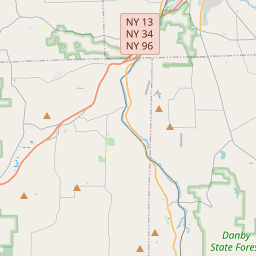Buttermilk Falls
Historical marker location:
106 East Buttermilk Falls Road, Ithaca, New York
( Marker can be reached from East Buttermilk Falls Road, 0.1 miles east of Elmira Road (New York State Route 96) when traveling east.)







© OpenStreetMap contributors
A Small Part of a Grand Watershed
Loading...
Searching for other points of interest within 3 miles of this location.The Stonewall Inn in Greenwich Village, New York City, was the site of the Stonewall riots in 1969, which are considered the birth of the modern gay rights movement.
About Tompkins County
Tompkins County Timeline
Tompkins County is located in upstate New York and is home to the City of Ithaca, which is its county seat. The region was originally inhabited by the indigenous Cayuga people, and European settlers began arriving in the late 18th century. The area was officially established as Tompkins County in 1817, named after Vice President Daniel D. Tompkins.
During the 19th century, Tompkins County experienced significant growth and development. The construction of the Cayuga and Seneca Canal in the 1820s connected the county to the Erie Canal, bringing increased trade and commerce to the area. The arrival of the railroad in the 1830s further facilitated economic growth and transportation. Agriculture became a major industry, with dairy farming, livestock raising, and fruit growing being prominent. In addition, the establishment of Cornell University in 1865 brought educational and research opportunities to the county.
Tompkins County was also known for its progressive and reformist movements in the late 19th and early 20th centuries. It became a center for the women's suffrage movement, with notable activists like Elizabeth Cady Stanton and Matilda Joslyn Gage residing in the area. The county was involved in the underground railroad, helping escaped slaves reach freedom in Canada.
In the latter part of the 20th century, Tompkins County experienced a shift towards a more diverse and knowledge-based economy. With Cornell University and Ithaca College as educational institutions, the county became known as a hub for research, technology, and higher education. Today, it continues to thrive as a center for innovation and progressive values, attracting people from various backgrounds to live and work in the area.
During the 19th century, Tompkins County experienced significant growth and development. The construction of the Cayuga and Seneca Canal in the 1820s connected the county to the Erie Canal, bringing increased trade and commerce to the area. The arrival of the railroad in the 1830s further facilitated economic growth and transportation. Agriculture became a major industry, with dairy farming, livestock raising, and fruit growing being prominent. In addition, the establishment of Cornell University in 1865 brought educational and research opportunities to the county.
Tompkins County was also known for its progressive and reformist movements in the late 19th and early 20th centuries. It became a center for the women's suffrage movement, with notable activists like Elizabeth Cady Stanton and Matilda Joslyn Gage residing in the area. The county was involved in the underground railroad, helping escaped slaves reach freedom in Canada.
In the latter part of the 20th century, Tompkins County experienced a shift towards a more diverse and knowledge-based economy. With Cornell University and Ithaca College as educational institutions, the county became known as a hub for research, technology, and higher education. Today, it continues to thrive as a center for innovation and progressive values, attracting people from various backgrounds to live and work in the area.
Tompkins County Timeline
This timeline provides a concise overview of the key events in the history of Tompkins County, New York.
- 1789: Tompkins County is established by the State of New York.
- 1794: Ithaca becomes the county seat.
- 1800: Cornell University is founded in Ithaca.
- 1817: The construction of the Erie Canal begins, bringing economic growth to the region.
- 1820: Tompkins County's population reaches 6,038.
- 1845: The village of Enfield is established.
- 1853: The Tompkins County Public Library is established.
- 1861-1865: Many Tompkins County residents fight in the American Civil War.
- 1901: The Taughannock Falls State Park is established.
- 1942: The Ithaca Gun Company suspends firearm production to focus on producing military ordnance during World War II.
- 1964: Ithaca is included in the newly created Appalachian Regional Commission.
- 1970: Ithaca College is established.
- 1987: The Sciencenter, a hands-on science museum, opens in Ithaca.
- 1999: The Tompkins County Public Library moves to its current location.
- 2016: Tompkins County establishes a Reimagining Public Safety Task Force to address community concerns about policing.